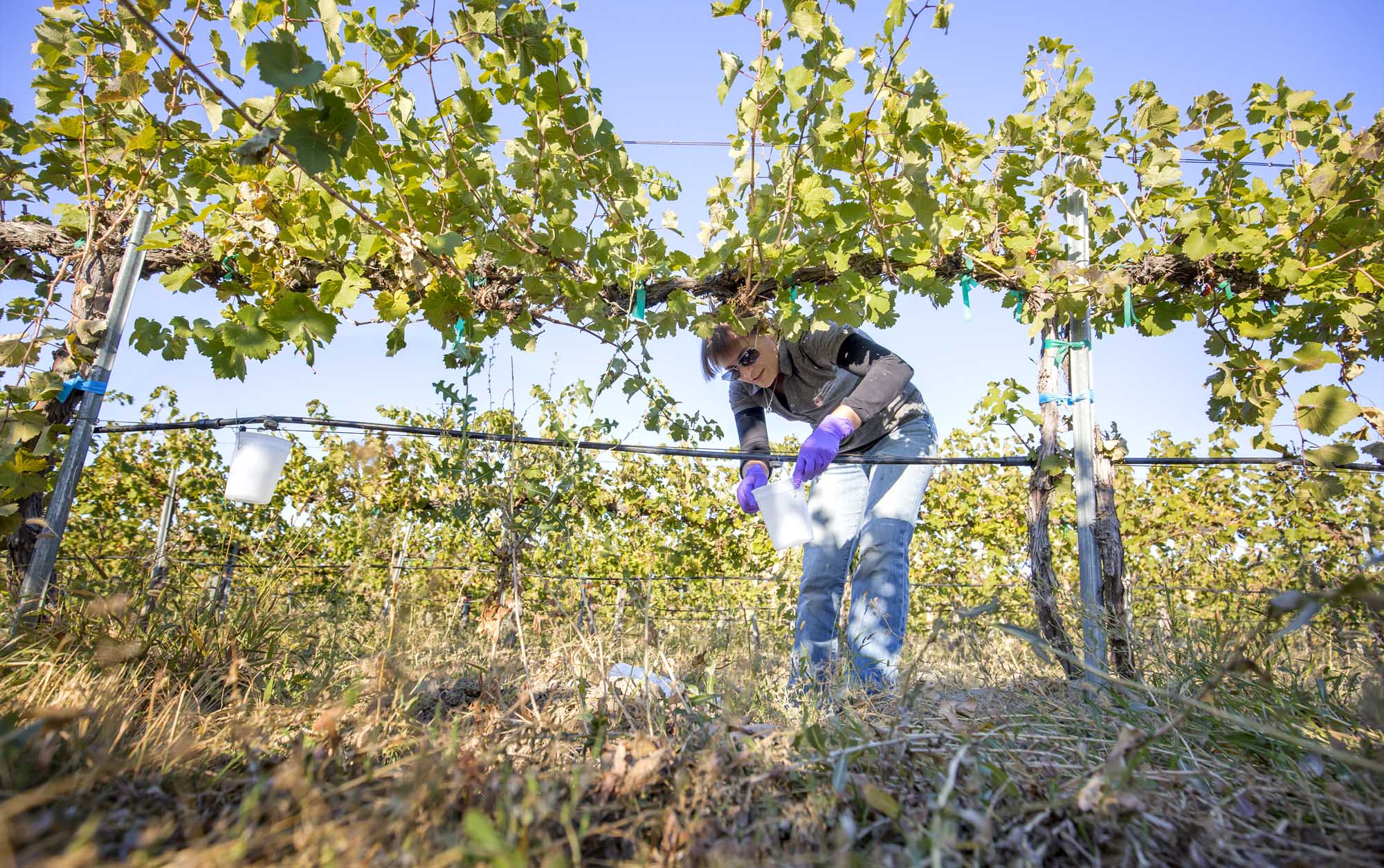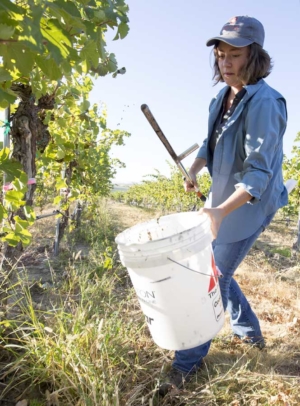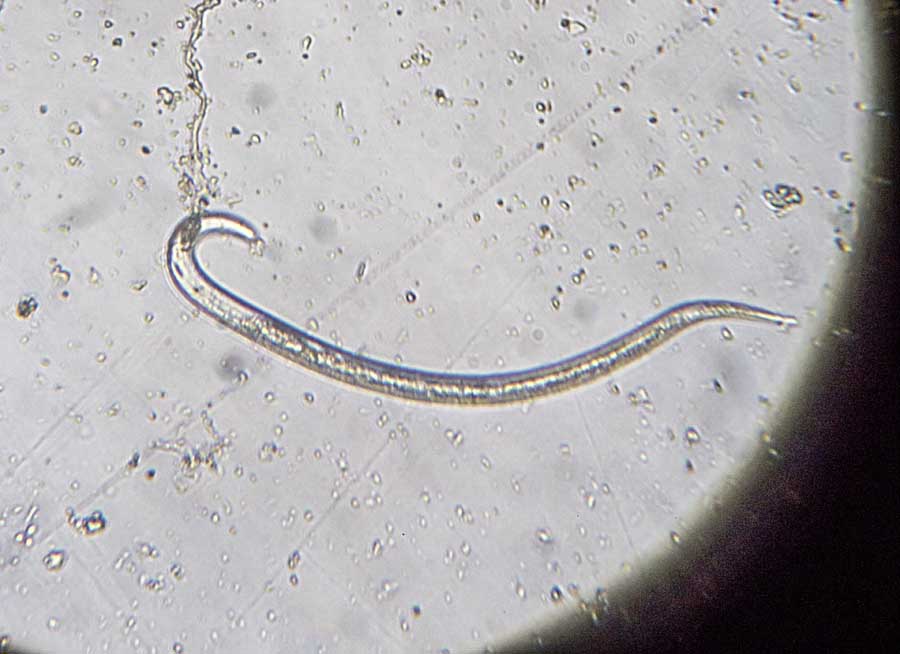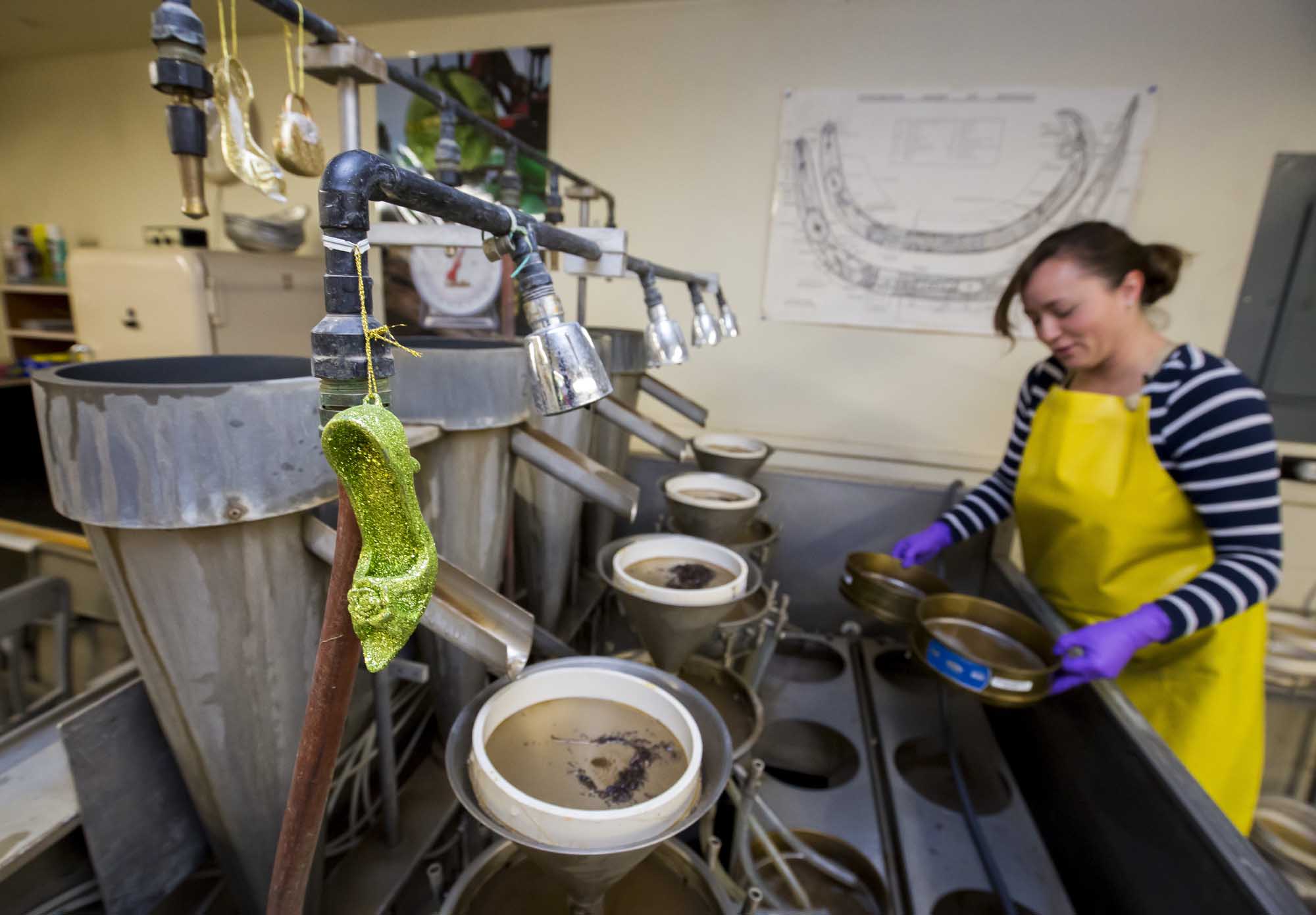
Michelle Moyer attaches containers to irrigation emitters in a Mattawa, Washington, vineyard that help disperse nematicides to evaluate their effectiveness. The work is part of a multiyear nematode study by Moyer, graduate student Katherine East and others from Washington State University. (TJ Mullinax/Good Fruit Grower)
Fighting an invisible enemy isn’t easy.
First, even figuring out if parasitic nematodes are hampering your vineyard’s performance presents a challenge: Soil tests can tell you how many nematodes you have, but scientists don’t yet know how many it takes to do economic damage. If damage is suspected, there’s little recourse beyond ripping up the vines, fumigating and replanting while hoping for the best.
There’s not much information to go on because northern root knot nematode and dagger nematode, the two species of concern for Washington grape growers, are extremely difficult to study, said Michelle Moyer, Washington State University Extension viticulturist.
“With nematodes, it takes a long time for decline symptoms to show up, and it takes a long time for symptoms to improve,” she said. Dagger nematode is a vector for diseases, such as fan leaf virus, while the root knot nematode is a major player in replant problems, because it attacks young roots and lowers production.
So in 2015, Moyer and her colleagues launched an ambitious, multipronged 10-year research project to figure out both the risks of and solutions for this under-the-radar, under-the-soil pest.
The effort includes testing the effectiveness of nematicides, fumigation and rootstocks; modeling the life cycle of the northern root knot nematode to figure out the best timing for controls; and developing an understanding of economic thresholds for management.
“It’s a full circle. What should you do before you go into planting, what should you plant, and if that fails, what can you use post-plant to extend the life of the vineyard,” Moyer said.
Growers should be concerned about nematodes if they are replanting on a former vineyard or orchard site, especially if there were problems with a nematode transmitted virus, such as tobacco ring spot, or a field that previously had potato, alfalfa or mint, said Inga Zasada, a U.S. Department of Agriculture nematologist and partner on the project during a presentation to the Washington State Grape Society in November.
Right now, there’s no established threshold for how many root knot or dagger nematodes pose a real threat, but she estimated that 250 root knot nematodes in 250 mg of soil might be a reasonable action level, or 25 daggers.
Given the challenges of fumigation — limited products and effectiveness — “plant resistance is cornerstone” to combat these pests in the future, Zasada said.
Rootstocks
The focal point of the research is a 6-acre test vineyard planted with Chardonnay in 2015 to measure the performance of vines over a decade. The research looks at both fumigated and non-fumigated blocks, different rootstocks and different levels of nematode pressure.
It’s too early to learn much from the vine performance, since the vineyard is still so young, Moyer said. The early data shows that the fumigation worked well on the dagger nematodes, who haven’t come back, but was quite short-lived for the root knot nematodes.

Katherine East taps out one of several soil samples from marked vines at a Mattawa, Washington, vineyard in September. East is collecting data on nematode populations to develop a degree-day model for northern root knot nematode at several sites in Central Washington. (TJ Mullinax/Good Fruit Grower)
“With the northern root knot nematode, we had a year and a half of protection, but now it’s the same” as the control, Zasada said. The question is whether that is enough time. “The goal is to give those young plants an environment without nematodes to get them up and running.”
Fresh root growth serves as a beacon to the nematodes, so populations tend to boom following new plantings, Zasada said. Fumigation aims to give vines a healthy start but does not remove nematodes from a site permanently.
That’s why rootstocks that are resistant to the pests could be an important tool for Washington growers, Moyer said. “It’s a management option Washington growers might not be ready for,” she added. “But every other temperate climate wine region uses rootstocks, so we can figure it out.”
The rootstocks selected for the trial were based on their performance in California vineyards, where the southern root knot nematode is one of the concerns.
Rootstocks in the trial are Teleski 5c, a rootstock used for its resistance to most nematodes and phylloxera; 101-14 MTG, a low-vigor rootstock with moderate nematode resistance as well as resistance to crown gall and phylloxera; 1103 Paulsen, a drought-resistant rootstock that’s moderately resistant to root knot nematode but susceptible to dagger nematode; and Harmony, specifically bred for nematode resistance and crown gall resistance. Own-rooted Chardonnay serves as the control.
“The rootstocks aren’t performing as well as we thought,” Zasada said, citing data from the first two years of the trial on nematode populations, including in areas where the researchers added extra nematodes to the existing soil to create very high pressure. “Teleski 5C is the only one that holds up as not a good host for the northern root knot nematode.”
The data so far raise an important question about resistance versus tolerance, Moyer said. Harmony, for example, is a vigorous rootstock that seems to have lots of nematodes in its roots but displays no symptoms because it can tolerate that level of parasitism without problems, she said.
That’s why she plans to continue the trial for 10 years, if not longer; the long-term impact on vine performance means more than the number of nematodes found in root systems.
“We often provide data for two to three years, but you don’t grow a vineyard for two to three years, you grow it for 20,” Moyer said, adding that she hopes this can be a long-term extension trial like Walter Clore’s famed variety trials, that can inform the industry for years to come.
Data collected includes nematode numbers, incidence of gall damage on root tips, dormant pruning weight and yield data. But Moyer and her students also plan to assess how well the rootstocks grow in the region, looking at things like drought tolerance, vigor and susceptibility to cold damage.
“Rootstocks have different properties and we use them as horticultural tools,” she said. “All of our irrigation and nutrition programs are based on own-rooted vines, and we’ve got that dialed in. So, with the adoption of rootstocks, how does that change?”
Nematicides
Once a vineyard is planted, there aren’t a lot of options for nematicides or information about how best to use them. That’s why the project includes a three-year efficacy trial looking at both registered and unregistered products.

A root knot nematode is visible under a microscope at the Washington State University Irrigated Agriculture Research and Extension Center in Prosser, Washington, in December. The nematode was one of many found by researcher Katherine East in soil samples she gathered from Washington vineyards earlier in the year. (TJ Mullinax/Good Fruit Grower)
The nematicides are dripped into the soil using little cups on each irrigation emitter — 10 vines per product — and at the end of the season, the vines are destructively harvested to get vine weights and ensure no fruit from the experiment ends up in wine.
Such trials are time consuming to do in perennial crop systems like vineyards because it takes so long to see whether the products actually improve yields or if they produce unwanted side effects, Moyer said. It’s also a lot of work collecting soil samples weekly and processing in the lab to identify and count nematodes.
Since the root knot nematodes are root parasites that spent much of their life cycle inside roots, it’s not always easy to target them with pesticides. The second juvenile stage is the most active in the soil and, therefore, the best stage to target for control, Moyer said.
That’s why Katherine East, one of Moyer’s graduate students, decided to focus on tracking their life cycle and how it times with the seasons.
Based on her data, a degree-day model for northern root knot nematode is now in development, which should guide nematicide and fumigation timing. Such models are a key part of nematode control in potatoes and other row crops, Zasada said.
Interestingly, their activity is “very closely tied to root development and irrigation,” Moyer said. In the spring and summer, the nematodes live inside the growing roots. Populations in the soil climb in the fall, peaking postharvest, and stay high through the winter, until the spring flush of root growth motivates them to move into the roots, she said. This suggests that it might be best to do fumigation in the fall after harvest.
Cultural practices
The new understanding of the root knot nematode’s life cycle and behavior suggests that deficit irrigation may offer a way to control the pest. Soil sampling always turns up high populations right under irrigation emitters, so it’s clear they like water.
“So, we wondered could drought stress actually help the vines outgrow nematodes?” Moyer said. She and her students also designed an experiment to see how the timing of cutting off irrigation in the fall alters the population of juvenile nematodes in the soil.
They are also conducting a greenhouse study to see if an ideal nutrition program can help the vines tolerate nematode parasitism with few symptoms.
It’s a lot of pieces to juggle but hopefully this wide-ranging project will provide growers with a suite of options for minimizing or mitigating damage from these oft-ignored pests.
The research is funded by the Washington Wine Commission, the U.S. Department of Agriculture, the nematicides companies whose products are given an unbiased analysis, and by the wine industry, including Ste. Michelle Wine Estates, Mercer Canyons and Hogue Ranches, who are maintaining vineyards for these experiments, and Inland Desert Nursery, which donated vines and grafting work. •
—by Kate Prengaman

A green sparkly shoe ornament hangs from “Gertrude,” an elutriator at the viticulture headhouse at the Washington State University Irrigated Agriculture Research and Extension Center in Prosser, Washington, in December. The near-antique elutriator is one of only six functioning machines in the U.S. and is a critical research tool used by several researchers in the Northwest. Katherine East, right, has spent countless hours working at the water basin sifting samples through its metal screens — and maintaining the temperamental machine. (TJ Mullinax/Good Fruit Grower)
Catching an invisible pest
All this nematode research relies on “Gertrude,” as researchers have nicknamed the machine that separates nematodes from the soil and roots at Washington State University’s Irrigated Agriculture Research and Extension Center in Prosser.

Katherine East rinses out filtered soil samples from “Gertrude” into containers looking for nematodes at the Washington State University, Irrigated Agriculture Research and Extension Center in Prosser, Washington, in December of 2017. East is also Gertrude’s primary caretaker for the nematode lab elutriator. East has been respectfully teased on occasion whenever the aged machine breaks. (TJ Mullinax/Good Fruit Grower)
Actually known as an elutriator, it looks like a series of funnels over a big metal sink. Soil samples are each placed in a funnel, which are then filled with water and air, trapping the nematodes on top of the little air bubbles that float to the surface so they can be collected in sieves.
Then, a skilled technician takes the extracted nematodes to a microscope for counting and identification. There are other species, such as the root lesion nematode that doesn’t feed on grapes, to exclude before counting dozens or even hundreds of root knot nematodes that can be found in just 250 grams of soil.
Katherine East, a graduate student working with viticulturist Michelle Moyer on the vineyard project, estimates that she’s well on her way to counting more than a million nematodes, between all the research components that require sampling for the pests.
The machine is one of just six in the country, Moyer said, and agricultural researchers near and far depend on it — even Inga Zasada, a U.S. Department of Agriculture nematologist based in Oregon, comes to Prosser to process samples. But, much like an old car, it can take quite a bit of tinkering to keep the elutriator running.
That’s why East and other researchers leave Gertrude small offerings — shining ornaments dangle from the frame — in hopes that they can keep the cantankerous, critical machine on its best behavior for continued research. New funding from the Washington Wine Industry Foundation will also help to refurbish Gertrude this year, Moyer said. —K. Prengaman






Leave A Comment